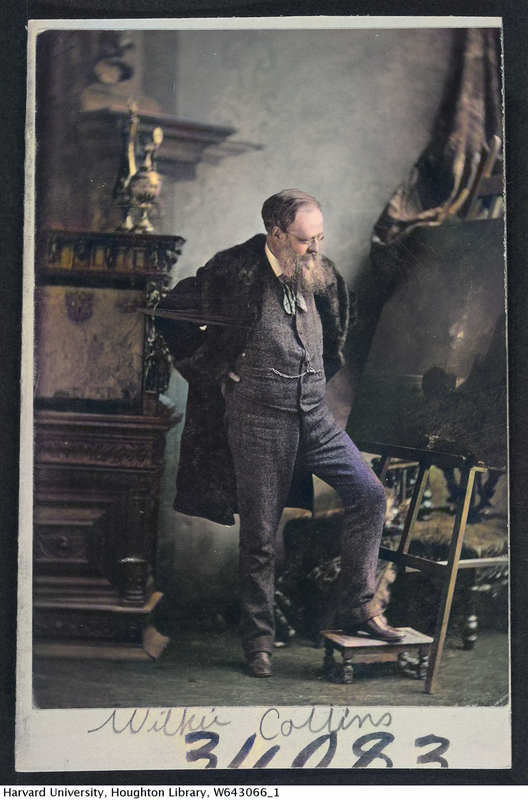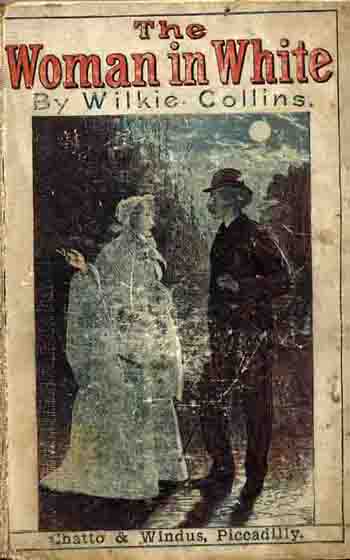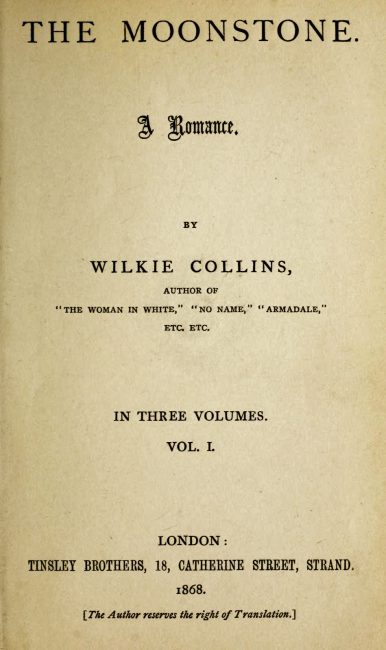
Cabinet card image of English author and playwright Wilkie Collins (1824-1889), Harvard Theatre Collection
On January 8, 1824, British novelist Wilkie Collins was born. Wilkie Collins is best known for his novels The Woman in White (1859) and The Moonstone (1868). The last has been called the first modern English detective novel.
“Ask yourself if there is any explanation of the mystery of your own life and death.”
– Wilkie Collins, The Haunted Hotel: A Mystery of Modern Venice (1878)
Wilkie Collins – Youth and Education
William Wilkie Collins was born in Marylebone, London, UK, to his father, William Collins, a well known landscape painter, and his mother Harriet, née Geddes. He received his nickname Wilkie because of his godfather David Wilkie, a well-known painter and friend of his father. Wilkie’s younger brother was the Pre-Raphaelite painter Charles Allston Collins. From 1836 to 1838, the Collins family travelled through France and Italy. The elder Wilkie Collins later described this trip as formative and extremely instructive for him. He said the country and the people in Italy taught him more, which he could also use, than he had ever learned in school. William Collins initially saw his son’s future not in art but in the tea trade. Thus, in late 1840, Collins left school at the age of nearly 17 and was apprenticed as a clerk to the firm of tea merchants Antrobus & Co. He got the job from Charles Ward, a family friend who worked at Coutts Bank for Edward E. Antrobus, the owner of the store. The apprenticeship had been procured for Wilkie by his father probably only to keep him busy. Wilkie could take vacations when he wanted and since his salary as an apprentice was not exactly ample, he was supported by his father in this regard.
First Writings
Collins started writing and published his first story, “The Last Stage Coachman“, in the Illuminated Magazine in August 1843. That year his brother Charles was also admitted to the Royal Academy School and began his career as a painter. In 1844 he travelled to Paris with 30-year-old Charles Ward, who at the time was courting Wilkie’s 18-year-old cousin Jane Carpenter and married her in February 1845. That same year he wrote his first novel, Iolani, or Tahiti as It Was; a Romance, which was submitted to Chapman and Hall but rejected in 1845. The novel remained unpublished during his lifetime. In 1846 the young man instead entered Lincoln’s Inn to study law, initiated by his father, who wanted him to have a steady income. Collins showed only a slight interest in law and spent most of his time with friends and on working on a second novel, Antonina, or the Fall of Rome, based on Bulwer-Lytton‘s novel The Last Days of Pompeii. Through this publication, which also helped him to gain some reputation, his decision to become a writer seemed to be finalized. After his father’s death in 1847, Collins produced his first published book, Memoirs of the Life of William Collins, Esq., R. A., published in 1848. He managed to complete his legal studies and was called to the bar in 1851. Though he never formally practised, he used his legal knowledge in many of his novels.
Charles Dickens
An instrumental event in his career was an introduction in March 1851 to Charles Dickens [1] by a mutual friend, through the painter Augustus Egg. They became lifelong friends and collaborators. In May of that year, Collins acted with Dickens in Edward Bulwer-Lytton’s play Not So Bad As We Seem. Among the audience were Queen Victoria and Prince Albert.[2] Collins’s story “A Terribly Strange Bed,” his first contribution to Dickens’s journal Household Words, was published in April 1852. Collins’s novel Basil was published by Bentley in November. During the writing of Hide and Seek, in early 1853, Collins suffered what was probably his first attack of gout, which would plague him for the rest of his life. During this period Collins extended the variety of his writing, publishing articles in George Henry Lewes‘s paper The Leader, short stories and essays for Bentley’s Miscellany, as well as dramatic criticism and the travel book Rambles Beyond Railways. His first play, The Lighthouse, was performed by Dickens’s theatrical company at Tavistock House, in 1855. His first collection of short stories, After Dark, was published in 1856. His novel A Rogue’s Life was serialized in Household Words also in March 1856. Around then, Collins began using laudanum regularly to treat his gout. He became addicted and struggled with that problem later in life.

Wilkie Collins, The Woman in White
The Woman in White
“My hour for tea is half-past five, and my buttered toast waits for nobody.”
– Wilkie Collins, The Woman in White (1859)
The novelist’s breakthrough success, however, came with his sensational novel “The Woman in White,” which first appeared in Dickens’s magazine “All The Year Round” from 1859 to 1860 and was immediately translated into almost all living languages. It is considered to be among the first mystery novels and is widely regarded as one of the first (and finest) in the genre of “sensation novels“. The story is sometimes considered an early example of detective fiction with protagonist Walter Hartright employing many of the sleuthing techniques of later private detectives. The use of multiple narrators (including nearly all the principal characters) draws on Collins’s legal training, and as he points out in his preamble: “the story here presented will be told by more than one pen, as the story of an offence against the laws is told in Court by more than one witness“. His rising success as a writer allowed Collins to resign his post with All the Year Round in 1862 and focus on his novels. While planning his next novel, No Name, he continued to suffer from gout, which began to affect his eyes. Serial publication of No Name began in early 1862 and finished in 1863. By that time Collins was having difficulty controlling the amount of laudanum he was taking for his continual gout and became addicted. At the beginning of 1863, he travelled with Caroline Graves to German spas and Italy for his health. In 1864, he began work on his novel Armadale, travelling in August to the Norfolk Broads and the village of Winterton-on-Sea do research for it. It was published serially in The Cornhill Magazine in 1864–1866.
The Moonstone
“We had our breakfasts–whatever happens in a house, robbery or murder, it doesn’t matter, you must have your breakfast.”
– Wilkie Collins, The Moonstone (1868)
His second most famous novel is The Moonstone, an epistolary novel and an early modern example of the detective novel. It established many of the ground rules of the modern genre. The Moonstone was serialized in All the Year Round from January to August 1868. The story wraps around the theft of a famous and rather precious Indian diamond. Rachel Verinder, a young English woman, inherits the diamond on her eighteenth birthday. In the night after her birthday celebration the diamond is stolen from her bedroom, and a period of turmoil, unhappiness, misunderstandings and ill luck ensues. Told by a series of narratives from some of the main characters, the complex plot traces the subsequent efforts to explain the theft, identify the thief, trace the stone and recover it. The novel was published in 1868, later than Edgar Allan Poe’s [4] short story mysteries “The Murders in the Rue Morgue” (1841), “The Mystery of Marie Rogêt” (1842) and “The Purloined Letter” (1845). However, The Moonstone introduced a number of the elements that became classic attributes of the twentieth-century detective story in novel form, as opposed to Poe’s short story form, as e.g., an English country house robbery, an “inside job“, red herrings, a celebrated, skilled, professional investigator, a bungling local constabulary, a large number of false suspects, the “least likely suspect”, as well as a final twist in the plot.

Wilkie Collins, The Moonstone, front page 1st edition 1868
Later Years
In 1870, his novel Man and Wife was published. That year Charles Dickens died, which caused him great sadness. In 1873–74, Collins toured the United States and Canada, giving readings of his work. The late work The Haunted Hotel (1878) represents a contribution to the Victorian Novel of Sensation that stands out from the crowd for its psychological content and what may be the first depiction of brain death in English-language literature. With his novel The Law and The Lady (1875), he wrote the first detective novel in literary history to feature a female detective. His later novels include Jezebel’s Daughter (1880), The Black Robe (1881), Heart and Science (1883), and The Evil Genius (1886). The inconsistent quality of Collins’s dramatic and fictional works in the last decade of his life was accompanied by a general decline in his health, including diminished eyesight. He was often unable to leave home and had difficulty writing.
Wilkie Collins died on September 23, 1889 in London at age 65, following a paralytic stroke.
Eric Carr, The Neverending Story : Lecture 7: Crime, [9]
References and Further Readings:
- [1] Charles Dickens – Famous Writer and Critic of the Victorian Era, SciHi Blog
- [2] Victoria and Albert – A Royal Wedding, SciHi Blog
- [3] Ernst von Wolzogen: Wilkie Collins. Ein biographisch-kritischer Versuch. Albert Unflad, Leipzig 1885
- [4] The Mysterious Death of Edgar Allan Poe, SciHi Blog
- [5] The Wilkie Collins Website
- [6] Works by or about Wilkie Collins at Internet Archive
- [7] “Archival material relating to Wilkie Collins”. UK National Archives.
- [8] Klimaszewski, Melisa (2011). Brief Lives: Wilkie Collins. London: Hesperus Press.
- [9] Eric Carr, The Neverending Story : Lecture 7: Crime, The Cultural Evolution of Narratives, CES Learning Modules
- [10] Wilkie Collins at Wikidata
- [11] Timeline for Wilkie Collins, via Wikidata and DBpedia





